Addiction treatment faces persistent challenges with patient engagement and retention, with average dropout rates around 30% across psychosocial treatments.
Equine therapy for drug addiction offers a unique solution by using structured interactions with horses to build therapeutic alliance, improve emotion regulation, and support recovery in ways traditional office-based therapy cannot.
This article explores the evidence behind equine-assisted interventions and explains how they enhance addiction treatment outcomes.
What is Equine Therapy for Addiction?
Equine therapy encompasses several distinct approaches that incorporate horses into structured therapeutic interventions. In addiction treatment settings, the most common forms include:
- Equine-Assisted Psychotherapy (EAP) involves licensed mental health clinicians conducting therapy sessions that integrate horse interactions to achieve specific treatment goals. These sessions typically focus on ground-based activities like grooming, leading, and herd observation rather than riding.
- Equine-Facilitated Psychotherapy (EFP) follows similar principles to EAP, with terminology varying by program and professional affiliations. Both approaches emphasize the therapeutic relationship between client, horse, and therapist.
- Horse-Assisted Therapy (HAT) is implemented within addiction programs by therapists with equine handling skills, often blending psychotherapy with horsemanship and stable activities to support recovery goals.
These modalities differ from hippotherapy, which primarily uses equine movement for physical rehabilitation and is less relevant to addiction treatment.
The Science Behind Equine Therapy in Addiction Recovery
Equine therapy isn’t just about spending time with horses, it’s grounded in psychology, neuroscience, and behavioral health principles. This section explores the scientific foundations that explain why working with horses can support healing and recovery.
Building Therapeutic Alliance and Engagement
Therapeutic alliance serves as a major predictor of retention and outcomes across all forms of psychotherapy, including addiction treatment. Strong early alliance reduces dropout risk, enhances motivation, and relates to session-by-session improvement.
Equine therapy excels at building alliances through the unique client-horse-therapist triad. Horses provide real-time nonverbal feedback, creating collaborative task focus and emotionally meaningful metaphors. Patients often report that the stable environment feels calming and authentic, enabling trust and participation even among those ambivalent about traditional talk therapy.
Addressing Emotion Regulation Deficits
A comprehensive meta-analysis of emotion regulation in substance use disorders found large deficits across multiple domains, with the greatest impairments in accessing adaptive strategies and impulse control when distressed. These deficits directly contribute to relapse risk and treatment dropout.
Equine sessions naturally elicit and practice regulation skills through:
- Mindfulness and attentional control when reading horse cues safely
- Distress tolerance and paced breathing while approaching large animals calmly
- Behavioral inhibition under arousal during groundwork exercises
- Cognitive reframing using metaphor and feedback from horse behavior
Supporting Trauma Recovery
Many individuals with substance use disorders have co-occurring trauma or PTSD. Integrated treatment approaches that address both conditions simultaneously produce better outcomes than treating them separately.
Equine therapy shows promise for trauma-related symptoms through experiential exposure, somatic regulation, and trust-building exercises. The non-judgmental presence of horses can help individuals practice interpersonal connection in a safe environment.

Clinical Evidence for Equine Therapy in Addiction Treatment
Beyond theory, equine therapy has been studied in clinical settings with promising results. Here, we take a closer look at research findings, patient outcomes, and the evidence supporting its role in treatment.
Treatment Retention and Completion
A prospective study of young adults in substance use disorder treatment found that horse-assisted therapy was associated with improved treatment retention and completion rates. Given that treatment completion strongly predicts long-term recovery outcomes, interventions that reliably reduce dropout carry significant practical importance.
Randomized Controlled Trial Results
A 2020 randomized controlled trial in Norway evaluated horse-assisted therapy as a complement to treatment-as-usual in addiction care. While the study established feasibility and provided proof-of-concept that equine interventions can be integrated into structured programs, the authors emphasized that rigorous trials remain limited and sample sizes small.
Qualitative Patient Experiences
Qualitative research studies reveal how patients experience equine therapy environments. Participants describe the stable as providing calming structure, purposeful tasks, authentic feedback from horses, and experiences of trust and mastery. These patient-centered themes align with common targets in addiction recovery, including distress tolerance, regulatory skills, and relational trust.
How Drug Rehab Centers Integrate Equine Therapy?
Many rehab centers now include equine therapy as part of holistic care programs. In the sections below, we’ll examine how it is structured, what patients experience during sessions, and how it complements traditional treatments.
Program Design Elements
Effective equine therapy programs in addiction treatment typically include:
- Structured sessions that combine psychoeducation with hands-on equine activities
- Themed progressions using concepts like listening, trusting, encouraging, and respecting
- Alliance monitoring to track therapeutic relationship development
- Integration with core treatments rather than replacement of evidence-based approaches
Target Populations
Research suggests certain groups may particularly benefit from equine therapy:
- Young adults with poor treatment engagement
- Individuals with co-occurring anxiety or PTSD
- Patients with significant emotion regulation difficulties
- Those who struggle with traditional office-based therapy approaches
Safety and Implementation
Professional equine facilitators, comprehensive risk protocols, and careful suitability screening are essential given the physical risks of working with large animals. Programs must also address access and equity considerations, as equine therapy can be resource-intensive.
Measuring Outcomes in Equine-Assisted Addiction Treatment
Comprehensive outcome measurement should extend beyond substance use alone to include:
- Engagement metrics: Attendance, session completion, early dropout rates
- Therapeutic alliance: Patient and therapist ratings of working relationship
- Emotion regulation: Validated measures of regulatory capacity and impulse control
- Distress and mood: Standardized assessments of anxiety and depression
- Functional outcomes: Housing stability, relationships, employment status
This multidimensional approach aligns with patient-centered care principles that recognize recovery encompasses more than abstinence alone.

Current Limitations and Future Directions
While equine therapy shows real potential, it still faces challenges such as limited accessibility, cost, and research gaps. This section highlights current limitations while also pointing to future areas for growth and innovation.
Evidence Gaps
The field needs larger, multi-site randomized controlled trials comparing equine therapy plus standard care versus standard care alone. Current studies are limited by small sample sizes, heterogeneous interventions, and insufficient follow-up periods.
Mechanism Research
Future studies should test whether improvements in therapeutic alliance and emotion regulation actually mediate reductions in substance use and relapse through longitudinal, repeated-measures designs.
Implementation Science
Research is needed on reach, adoption, fidelity, cost-effectiveness, and sustainability in community programs, particularly addressing access disparities.
A Realistic Perspective on Equine Therapy’s Role
Based on current evidence, equine therapy is best positioned as a mechanism-directed adjunct rather than a replacement for core addiction treatments. The strongest case exists for using equine interventions to:
- Enhance therapeutic alliance and reduce distress early in treatment
- Provide experiential practice contexts for emotion regulation skills
- Support engagement among patients at risk of early dropout
- Address trauma-related symptoms in integrated treatment approaches
Claims about direct reductions in substance use remain premature without larger trials. However, strategically using equine therapy to improve alliance, reduce distress, and teach regulation skills is both plausible and supported by related evidence showing these process changes mediate better outcomes.
Why Equine Therapy Matters for Recovery?
Equine therapy helps addiction treatment by making the rest of treatment more likely to succeed. Through enhanced engagement, improved emotion regulation, and strengthened therapeutic relationships, these interventions create the conditions under which evidence-based treatments can be most effective.
For individuals struggling with traditional approaches, particularly those with trauma histories or significant emotion regulation difficulties, equine therapy offers an alternative pathway to therapeutic engagement. The stable environment provides a unique setting where trust, mastery, and emotional processing can occur naturally through interaction with horses.
While the field continues developing more rigorous evidence, current research supports equine therapy as a valuable adjunct within comprehensive, measurement-based addiction care. Programs implementing these interventions should maintain realistic expectations, track meaningful outcomes, and integrate equine work with established evidence-based treatments.
If you or a loved one could benefit from innovative approaches to addiction treatment that include holistic therapies like equine-assisted interventions, consider reaching out to Thoroughbred to learn about comprehensive treatment programs that combine evidence-based care with experiential healing modalities.









